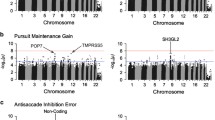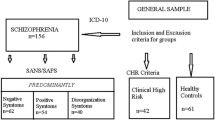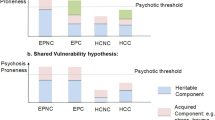Abstract
Background
Deficits in antisaccade (AS) and smooth pursuit eye movements (SPEM) are promising endophenotypes in genetic studies of schizophrenia. The Icelandic population lends itself ideally to genetic studies due to its ethnic homogeneity and well-documented genealogy. The primary aim of this study was to assess AS and SPEM performance in a large Icelandic sample. Additional aims were to investigate the relationship between AS and SPEM task performance and to assess internal consistency, within-session performance changes and effects of SPEM target velocity on performance.
Method
Patients with schizophrenia (N = 118) and healthy controls (N = 109) matched for age and gender underwent infrared oculographic assessment of AS and SPEM (at target velocities of 12°, 24° and 36°/s).
Results
On the AS task patients displayed significantly more reflexive errors, longer latency, increased intra-individual latency variability, and reduced amplitude gain compared to controls. On the SPEM task, patients had significantly lower velocity gain and more frequent saccades during pursuit at all velocities, but group differences in velocity gain increased with increasing target velocity. Internal consistency of performance was high for all variables in both groups (Cronbach’s alpha >0.77 for AS and >0.85 for SPEM) except for AS spatial error in patients (alpha = 0.38). A moderate association was found between AS and SPEM performance. By and large, patients and controls showed similar patterns of systematic within-session performance changes.
Conclusions
Our findings confirm the existence of robust eye movement deficits in schizophrenia in a large sample. These measures may be studied as endophenotypes in future studies of potential schizophrenia risk genotypes in the genetically homogenous Icelandic population.



Similar content being viewed by others
References
Amador XF, Malaspina D, Sackeim HA, Coleman EA, Kaufmann CA, Hasan A, Gorman JM (1995) Visual fixation and smooth pursuit eye movement abnormalities in patients with schizophrenia and their relatives. J Neuropsychiatry Clin Neurosci 7:197–206
Antoniades CA, Altham PM, Mason SL, Barker RA, Carpenter R (2007) Saccadometry: a new tool for evaluating presymptomatic Huntington patients. Neuroreport 18:1133–1136
Braff DL, Freedman R, Schork NJ, Gottesman II (2007) Deconstructing schizophrenia: an overview of the use of endophenotypes in order to understand a complex disorder. Schizophr Bull 33:21–32
Broerse A, Crawford TJ, den Boer JA (2001) Parsing cognition in schizophrenia using saccadic eye movements: a selective overview. Neuropsychologia 39:742–756
Calkins ME, Curtis CE, Iacono WG, Grove WM (2004) Antisaccade performance is impaired in medically and psychiatrically healthy biological relatives of schizophrenia patients. Schizophr Res 71:167–178
Calkins ME, Iacono WG (2000) Eye movement dysfunction in schizophrenia: a heritable characteristic for enhancing phenotype definition. Am J Med Genet 97:72–76
Calkins ME, Iacono WG, Curtis CE (2003) Smooth pursuit and antisaccade performance evidence trait stability in schizophrenia patients and their relatives. Int J Psychophysiol 49:139–146
Cegalis JA, Sweeney JA (1979) Eye movements in schizophrenia: a quantitative analysis. Biol Psychiatry 14:13–26
Cegalis JA, Sweeney JA, Dellis EM (1982) Refixation saccades and attention in schizophrenia. Psychiatry Res 7:189–198
Chen Y, Nakayama K, Levy DL, Matthysse S, Holzman PS (1999) Psychophysical isolation of a motion-processing deficit in schizophrenics and their relatives and its association with impaired smooth pursuit. Proc Natl Acad Sci USA 96:4724–4729
Clementz BA, McDowell JE, Zisook S (1994) Saccadic system functioning among schizophrenia patients and their first-degree biological relatives. J Abnorm Psychol 103:277–287
Crawford TJ, Haeger B, Kennard C, Reveley MA, Henderson L (1995) Saccadic abnormalities in psychotic patients. II. The role of neuroleptic treatment. Psychol Med 25:473–483
Crawford TJ, Sharma T, Puri BK, Murray RM, Berridge DM, Lewis SW (1998) Saccadic eye movements in families multiply affected with schizophrenia: the Maudsley Family Study. Am J Psychiatry 155:1703–1710
Cronbach LJ, Warrington WG (1951) Time-limit tests: estimating their reliability and degree of speeding. Psychometrika 16:167–188
Curtis CE, Calkins ME, Iacono WG (2001) Saccadic disinhibition in schizophrenia patients and their first-degree biological relatives. A parametric study of the effects of increasing inhibitory load. Exp Brain Res 137:228–236
Depatie L, O’Driscoll GA, Holahan AL, Atkinson V, Thavundayil JX, Kin NN, Lal S (2002) Nicotine and behavioral markers of risk for schizophrenia: a double-blind, placebo-controlled, cross-over study. Neuropsychopharmacology 27:1056–1070
Ettinger U, Kumari V, Crawford TJ, Corr PJ, Das M, Zachariah E, Hughes C, Sumich AL, Rabe-Hesketh S, Sharma T (2004) Smooth pursuit and antisaccade eye movements in siblings discordant for schizophrenia. J Psychiatr Res 38:177–184
Ettinger U, Kumari V, Crawford TJ, Davis RE, Sharma T, Corr PJ (2003) Reliability of smooth pursuit, fixation, and saccadic eye movements. Psychophysiology 40:620–628
Ettinger U, Picchioni M, Hall MH, Schulze K, Toulopoulou T, Landau S, Crawford TJ, Murray RM (2006) Antisaccade performance in monozygotic twins discordant for schizophrenia: the Maudsley twin study. Am J Psychiatry 163:543–545
Evans WJ, Schwartz BD (1997) Attentional mechanisms of saccadic eye movements in schizophrenia. Neuropsychiatry Neuropsychol Behav Neurol 10:17–24
Flechtner KM, Steinacher B, Sauer R, Mackert A (2002) Smooth pursuit eye movements of patients with schizophrenia and affective disorder during clinical treatment. Eur Arch Psychiatry Clin Neurosci 252:49–53
Friedman L, Jesberger JA, Meltzer HY (1991) A model of smooth pursuit performance illustrates the relationship between gain, catch-up saccade rate, and catch-up saccade amplitude in normal controls and patients with schizophrenia. Biol Psychiatry 30:537–556
Fukushima J, Morita N, Fukushima K, Chiba T, Tanaka S, Yamashita I (1990) Voluntary control of saccadic eye movements in patients with schizophrenic and affective disorders. J Psychiatr Res 24:9–24
Gooding DC, Grabowski JA, Hendershot CS (2000) Fixation stability in schizophrenia, bipolar, and control subjects. Psychiatry Res 97:119–128
Gooding DC, Iacono WG, Beiser M (1994) Temporal stability of smooth-pursuit eye tracking in first-episode psychosis. Psychophysiology 31:62–67
Harrison PJ, Weinberger DR (2005) Schizophrenia genes, gene expression, and neuropathology: on the matter of their convergence. Mol Psychiatry 10:40–68; image 45
Helgason A, Yngvadottir B, Hrafnkelsson B, Gulcher J, Stefansson K (2005) An Icelandic example of the impact of population structure on association studies. Nat Genet 37:90–95
Holzman PS, Proctor LR, Levy DL, Yasillo NJ, Meltzer HY, Hurt SW (1974) Eye-tracking dysfunctions in schizophrenic patients and their relatives. Arch Gen Psychiatry 31:143–151
Hommer DW, Clem T, Litman R, Pickar D (1991) Maladaptive anticipatory saccades in schizophrenia. Biol Psychiatry 30:779–794
Hong LE, Mitchell BD, Avila MT, Adami H, McMahon RP, Thaker GK (2006) Familial aggregation of eye-tracking endophenotypes in families of schizophrenic patients. Arch Gen Psychiatry 63:259–264
Hong LE, Tagamets M, Avila M, Wonodi I, Holcomb H, Thaker GK (2005) Specific motion processing pathway deficit during eye tracking in schizophrenia: a performance-matched functional magnetic resonance imaging study. Biol Psychiatry 57:726–732
Hutton SB, Crawford TJ, Gibbins H, Cuthbert I, Barnes TR, Kennard C, Joyce EM (2001) Short and long term effects of antipsychotic medication on smooth pursuit eye tracking in schizophrenia. Psychopharmacology (Berl) 157:284–291
Hutton SB, Crawford TJ, Kennard C, Barnes TR, Joyce EM (2000) Smooth pursuit eye tracking over a structured background in first-episode schizophrenic patients. Eur Arch Psychiatry Clin Neurosci 250:221–225
Hutton SB, Crawford TJ, Puri BK, Duncan LJ, Chapman M, Kennard C, Barnes TR, Joyce EM (1998) Smooth pursuit and saccadic abnormalities in first-episode schizophrenia. Psychol Med 28:685–692
Hutton SB, Ettinger U (2006) The antisaccade task as a research tool in psychopathology: a critical review. Psychophysiology 43:302–313
Kaiser S, Roth A, Rentrop M, Friederich HC, Bender S, Weisbrod M (2008) Intra-individual reaction time variability in schizophrenia, depression and borderline personality disorder. Brain Cogn 66:73–82
Karoumi B, Ventre-Dominey J, Vighetto A, Dalery J, d’Amato T (1998) Saccadic eye movements in schizophrenic patients. Psychiatry Res 77:9–19
Katsanis J, Iacono WG (1991) Clinical, neuropsychological, and brain structural correlates of smooth-pursuit eye tracking performance in chronic schizophrenia. J Abnorm Psychol 100:526–534
Katsanis J, Kortenkamp S, Iacono WG, Grove WM (1997) Antisaccade performance in patients with schizophrenia and affective disorder. J Abnorm Psychol 106:468–472
Katsanis J, Taylor J, Iacono WG, Hammer MA (2000) Heritability of different measures of smooth pursuit eye tracking dysfunction: a study of normal twins. Psychophysiology 37:724–730
Kay SR, Fiszbein A, Opler LA (1987) The positive and negative syndrome scale (PANSS) for schizophrenia. Schizophr Bull 13:261–276
Kelly P, Rennie C, Gordon E, Anderson J, Howson A, Meares R (1990) Smooth pursuit eye tracking dysfunction and negative symptoms in schizophrenia. Psychiatry Res 34:89–97
Kissler J, Clementz BA (1998) Fixation stability among schizophrenia patients. Neuropsychobiology 38:57–62
Klein C, Heinks T, Andresen B, Berg P, Moritz S (2000) Impaired modulation of the saccadic contingent negative variation preceding antisaccades in schizophrenia. Biol Psychiatry 47:978–990
Klein C, Wendling K, Huettner P, Ruder H, Peper M (2006) Intra-subject variability in attention-deficit hyperactivity disorder. Biol Psychiatry 60:1088–1097
Krebs MO, Gut-Fayand A, Amado I, Daban C, Bourdel MC, Poirier MF, Berthoz A (2001) Impairment of predictive saccades in schizophrenia. Neuroreport 12:465–469
Leigh R, Zee D (1999) Neurology of eye movments. Oxford University Press, Oxford
Lencer R, Nagel M, Sprenger A, Heide W, Binkofski F (2005) Reduced neuronal activity in the V5 complex underlies smooth-pursuit deficit in schizophrenia: evidence from an fMRI study. Neuroimage 24:1256–1259
Lencer R, Trillenberg-Krecker K, Schwinger E, Arolt V (2003) Schizophrenia spectrum disorders and eye tracking dysfunction in singleton and multiplex schizophrenia families. Schizophr Res 60:33–45
Levy DL, Holzman PS, Matthysse S, Mendell NR (1993) Eye tracking dysfunction and schizophrenia: a critical perspective. Schizophr Bull 19:461–536
Lichtermann D, Karbe E, Maier W (2000) The genetic epidemiology of schizophrenia and of schizophrenia spectrum disorders. Eur Arch Psychiatry Clin Neurosci 250:304–310
Litman RE, Torrey EF, Hommer DW, Radant AR, Pickar D, Weinberger DR (1997) A quantitative analysis of smooth pursuit eye tracking in monozygotic twins discordant for schizophrenia. Arch Gen Psychiatry 54:417–426
Mackert A, Flechtner M (1989) Saccadic reaction times in acute and remitted schizophrenics. Eur Arch Psychiatry Neurol Sci 239:33–38
Malone SM, Iacono WG (2002) Error rate on the antisaccade task: heritability and developmental change in performance among preadolescent and late-adolescent female twin youth. Psychophysiology 39:664–673
Moon SY, Barton JJ, Mikulski S, Polli FE, Cain MS, Vangel M, Hamalainen MS, Manoach DS (2007) Where left becomes right: a magnetoencephalographic study of sensorimotor transformation for antisaccades. Neuroimage 36:1313–1323
Matsue Y, Saito H, Osakabe K, Awata S, Ueno T, Matsuoka H, Chiba H, Fuse Y, Sato M (1994) Smooth pursuit eye movements and voluntary control of saccades in the antisaccade task in schizophrenic patients. Jpn J Psychiatry Neurol 48:13–22
Matsue Y, Sugawara S, Oyama K, Osakabe K, Awata S, Goto Y, Sato M (1993) Smooth pursuit eye movement dysfunction as a biological marker for prediction of disease courses of schizophrenia: a preliminary report. Jpn J Psychiatry Neurol 47:71–74
McDowell JE, Clementz BA (2001) Behavioral and brain imaging studies of saccadic performance in schizophrenia. Biol Psychol 57:5–22
McDowell JE, Myles-Worsley M, Coon H, Byerley W, Clementz BA (1999) Measuring liability for schizophrenia using optimized antisaccade stimulus parameters. Psychophysiology 36:138–141
Mosimann UP, Felblinger J, Colloby SJ, Muri RM (2004) Verbal instructions and top-down saccade control. Exp Brain Res 159:263–267
Nagel M, Sprenger A, Nitschke M, Zapf S, Heide W, Binkofski F, Lencer R (2007) Different extraretinal neuronal mechanisms of smooth pursuit eye movements in schizophrenia: an fMRI study. Neuroimage 34:300–309
Nkam I, Thibaut F, Denise P, Van Der Elst A, Segard L, Brazo P, Menard J, Thery S, Halbeck I, Delamilleure P, Vasse T, Etard O, Dollfus S, Champion D, Levillain D, Petit M (2001) Saccadic and smooth-pursuit eye movements in deficit and non-deficit schizophrenia. Schizophr Res 48:145–153
Radant AD, Hommer DW (1992) A quantitative analysis of saccades and smooth pursuit during visual pursuit tracking. A comparison of schizophrenics with normals and substance abusing controls. Schizophr Res 6:225–235
Raemaekers M, Jansma JM, Cahn W, Van der Geest JN, van der Linden JA, Kahn RS, Ramsey NF (2002) Neuronal substrate of the saccadic inhibition deficit in schizophrenia investigated with 3-dimensional event-related functional magnetic resonance imaging. Arch Gen Psychiatry 59:313–320
Reuter B, Kathmann N (2004) Using saccade tasks as a tool to analyze executive dysfunctions in schizophrenia. Acta Psychol (Amst) 115:255–269
Reuter B, Rakusan L, Kathmanna N (2005) Poor antisaccade performance in schizophrenia: an inhibition deficit? Psychiatry Res 135:1–10
Riley B, Kendler KS (2006) Molecular genetic studies of schizophrenia. Eur J Hum Genet 14:669–680
Schlenker R, Cohen R (1995) Smooth-pursuit eye-movement dysfunction and motor control in schizophrenia: a follow-up study. Eur Arch Psychiatry Clin Neurosci 245:125–126
Schwartz BD, O’Brien BA, Evans WJ, McDermott BE, Sautter FJ, Winstead DK Jr (1995) Abnormal saccadic eye movements associated with positive family history schizophrenics. Biol Psychiatry 38:487–491
Sereno AB, Holzman PS (1995) Antisaccades and smooth pursuit eye movements in schizophrenia. Biol Psychiatry 37:394–401
Sheehan DV, Lecrubier Y, Sheehan KH, Amorim P, Janavs J, Weiller E, Hergueta T, Baker R, Dunbar GC (1998) The Mini-International Neuropsychiatric Interview (M.I.N.I.): the development and validation of a structured diagnostic psychiatric interview for DSM-IV and ICD-10. J Clin Psychiatry 59(Suppl 20):22–33;quiz 34–57
Siever LJ, van Kammen DP, Linnoila M, Alterman I, Hare T, Murphy DL (1986) Smooth pursuit eye movement disorder and its psychobiologic correlates in unmedicated schizophrenics. Biol Psychiatry 21:1167–1174
Smyrnis N, Evdokimidis I, Stefanis NC, Constantinidis TS, Avramopoulos D, Theleritis C, Paximadis C, Efstratiadis C, Kastrinakis G, Stefanis CN (2002) The antisaccade task in a sample of 2,006 young males. II. Effects of task parameters. Exp Brain Res 147:53–63
Spitzer R, Endicott J (1977) The schedule for affective disorders and schizophrenia, lifetime version. NewYork State Psychiatric Institute, New York
Spitzer RL, Endicott J, Robins E (1978) Research diagnostic criteria: rationale and reliability. Arch Gen Psychiatry 35:773–782
Sweeney JA, Bauer KS, Keshavan MS, Haas GL, Schooler NR, Kroboth PD (1997) Adverse effects of risperidone on eye movement activity: a comparison of risperidone and haloperidol in antipsychotic-naive schizophrenic patients. Neuropsychopharmacology 16:217–228
Sweeney JA, Clementz BA, Haas GL, Escobar MD, Drake K, Frances AJ (1994) Eye tracking dysfunction in schizophrenia: characterization of component eye movement abnormalities, diagnostic specificity, and the role of attention. J Abnorm Psychol 103:222–230
Sweeney JA, Luna B, Srinivasagam NM, Keshavan MS, Schooler NR, Haas GL, Carl JR (1998) Eye tracking abnormalities in schizophrenia: evidence for dysfunction in the frontal eye fields. Biol Psychiatry 44:698–708
Thaker GK, Avila MT, Hong EL, Medoff DR, Ross DE, Adami HM (2003) A model of smooth pursuit eye movement deficit associated with the schizophrenia phenotype. Psychophysiology 40:277–284
Tien AY, Ross DE, Pearlson G, Strauss ME (1996) Eye movements and psychopathology in schizophrenia and bipolar disorder. J Nerv Ment Dis 184:331–338
Acknowledgments
The study was supported by a grant from the Icelandic Research Fund (RANNIS). Ulrich Ettinger is supported by an ESRC/MRC Fellowship. We would like to thank Dr S.B. Hutton (s.hutton@sussex.ac.uk) for writing the SPEM analysis software.
Author information
Authors and Affiliations
Corresponding author
Rights and permissions
About this article
Cite this article
Haraldsson, H.M., Ettinger, U., Magnusdottir, B.B. et al. Eye movement deficits in schizophrenia. Eur Arch Psychiatry Clin Neurosc 258, 373–383 (2008). https://doi.org/10.1007/s00406-008-0806-y
Received:
Accepted:
Published:
Issue Date:
DOI: https://doi.org/10.1007/s00406-008-0806-y




